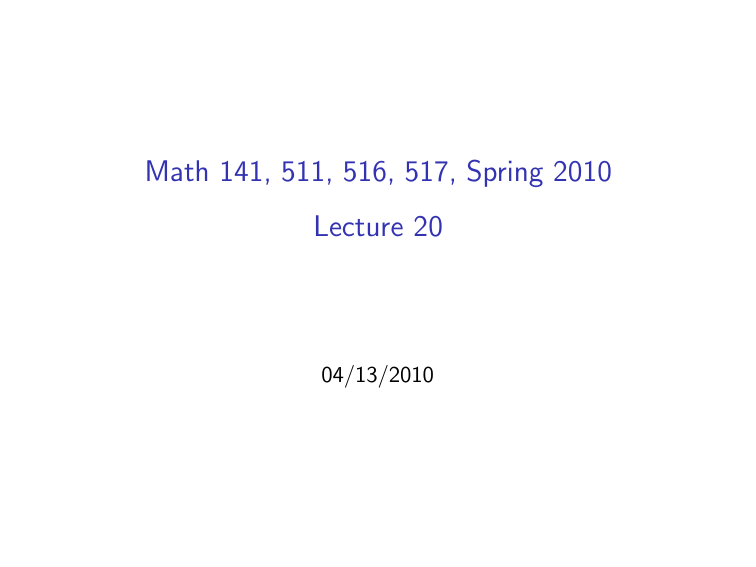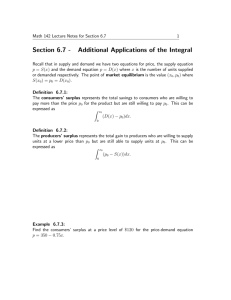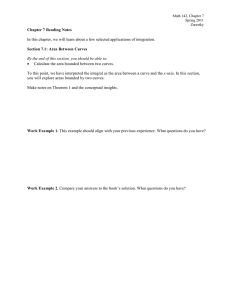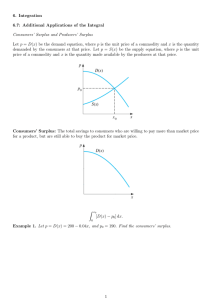Math 141, 511, 516, 517, Spring 2010 Lecture 20 04/13/2010
advertisement

Math 141, 511, 516, 517, Spring 2010 Lecture 20 04/13/2010 Homework #25 (Section 6-5) Homework #26 (Section 7-1) Homework #27 (Section 7-2) are due Thursday, April 15, 11:55 PM. Quiz 11 will be held on Thursday, April 15. It will cover sections 7-1, 7-2, 8-1. Section 7-2. Applications in business and economics. Consumers’ and producers’ surplus. Definition. Consumers’ Surplus If (x̄, p̄) is a point on the graph of the price-demand equation p = D(x) for a particular product, then the consumers’ surplus CS at a price level of p̄ is CS = Zx̄ [D(x) − p̄]dx 0 which is the area between p = p̄ and p = D(x) from x = 0 to x = x̄. The consumers’ surplus represents the total savings to consumers who are willing to pay more that p̄ for the product, but are still able to buy the product for p̄. Definition. Producers’ surplus. If (x̄, p̄) is a point on the graph of the price-supply equation p = S(x), then the producers’ surplus PS at a price level of p̄ is PS = Zx̄ [p̄ − S(x)]dx 0 which is the area between p = p̄ and p = S(x) from x = 0 to x = x̄. The producers’ surplus represents the total gain to producers who are willing to supply units at a lower price that p̄ but are still able to supply units at p̄. If p = D(x) and p = S(x) are the price-demand and price-supply equations, respectively, for a product and if (x̄, p̄) is the point of intersection of these equations, then p̄ is called the equilibrium price and x̄ is called the equilibrium quantity. If the price stabilizes at the equilibrium price p̄, then this is the price level that will determine both the consumers’ surplus and the producers’ surplus. Example 1. Find the equilibrium price and then find the consumers’ surplus and producers’ surplus at the equilibrium price level if p = D(x) = 50 − 0.1x, p = S(x) = 11 + 0.05x. Chapter 8. Multivariable calculus. Section 8-1. Functions of several variables. An equation of the form z = f (x, y ) describes a function of two variables if, for each permissible ordered pair (x, y ), there is one and only one value of z determined by f (x, y ). The variables x and y are independent variables, and the variable z is a dependent variable. The set of all ordered pairs of permissible values of x and y is the domain of the function, and the set of all corresponding values f (x, y ) is the range of the function. We will assume that the domain of a function z = f (x, y ) is the set of all ordered pairs of real numbers (x, y ) such that f (x, y ) is also a real number. Similarly we can define functions of three and more variables. Example 2. Let f (x, y ) = 2x − 3y + 4. Find f (4, −2). r tn . Find Example 3. Let A(P, r , t, n) = P 1 + n A(10, 0.04, 3, 2). Example 4. A company manufactures 10- and 13- speed bicycles. The weekly demand and cost equations are p = 230 − 9x + y q = 130 + x − 4y C (x, y ) = 200 + 80x + 30y where $p is the price of a 10-speed bicycle, $q is the price of a 13-speed bicycle, x is the weekly demand for 10-speed bicycle, y is the weekly demand for 13-speed bicycle, C (x, y ) is the cost function. Find the weekly revenue function R(x, y ) and the weekly profit function P(x, y ). Evaluate R(10, 15) and P(10, 15). Cobb-Douglas production function f (x, y ) = kx m y n where k, m, and n are positive constants with m + n = 1. Economists use this function to describe the number of units f (x, y ) produced from the utilization of x units of labor and y units of capital (for equipment such as tools, machinery, buildings and so on). Example 5. The Cobb-Douglas production function for a petroleum company is given by f (x, y ) = 10x 0.4 y 0.6 where x is the utilization of labor and y is the utilization of capital. If the company uses 1250 units of labor and 1700 units of capital, how many units of petroleum will be produced? Three-dimensional coordinate system. We first choose a fixed point O (the origin) and tree directed lines through O that are perpendicular to each other, called the coordinate axes and labeled the x-axis, y -axis, and z-axis. Usually we think of the x and y -axes as being horizontal and z-axis as being vertical. The three coordinate axes determine the three coordinate planes. The xy -plane contains the x- and y -axes and its equation is z = 0, the xz-plane contains the x- and z-axes and its equation is y = 0, The yz-plane contains the y - and z-axes and its equation is x = 0. These three coordinate planes divide space into eight parts called octants. The first octant is determined by positive axes. Take a point P in space, let a be directed distance from yz-plane to P, b be directed distance from xz-plane to P, and c be directed distance from xy -plane to P. We represent the point P by the ordered triple (a, b, c) of real numbers, and we call a, b, and c the coordinates of P. Example 6. Let f (x, y ) = 100 + 10x + 25y − x 2 − 5y 2 . Describe the cross-sections of the surface z = f (x, y ) produced by cutting it with the planes x = 1 and y = 3.








